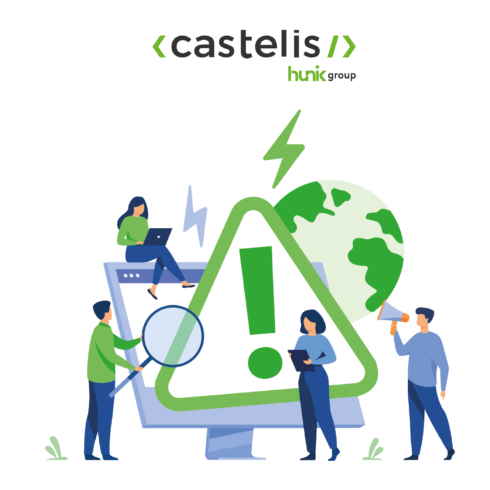
What is Green IT or responsible digital ?
Environmental issues affect all sectors of the economy, including digital. With the ever-increasing development of digital technology, adopting a more responsible approach is now essential. Especially since it is possible to reduce the company’s carbon footprint and offer an IS that has less impact on the environment. To do this, it is necessary to put in place a Green IT approach.
What is behind this term and how to adopt a responsible digital approach ? Whose responsibility is it ? How can your digital solution providers and partners, such as Castelis, also play a key role in your company’s environmental footprint ?
What is digital responsibility ?
Green IT, or responsible digital, designates the solutions that enable companies to reduce the carbon impact of digital technology and their energy consumption.
Indeed, IT is a field that has a significant environmental impact. The digital sector produces between 4 and 5% of greenhouse gas emissions worldwide. These emissions come from equipment, networks and computer centers. They come from both the manufacturing of digital objects and their daily use. Their end-of-life also poses a problem, due to the management of digital waste.
The ecological digital aims to propose a responsible approach by preparing the digital transition of the company. This is an essential challenge to take up in order to preserve the environment. The impact of the exponential development of ICT tools (Information and Communication Technologies) could be equivalent to that of cars by 2050 if nothing is done.
This means that at Castelis, and more globally, at hunik group, we are committed to reducing the environmental impact of the solutions we offer, both for hosting and for web development.
What are the benefits of Green IT ?
Green IT not only has ecological implications, it also has other benefits. In addition to reducing the company’s carbon footprint, a green IT structure involves making a number of advances:
- Energy savings: by adopting sustainable habits, it is possible to reduce the cost of bills, especially for electricity consumption.
- Improved performance of information systems with redesigned equipment and adapted usage. The more optimized the code, the lighter it is, the faster the pages load. If websites and web applications load fast, not only will less energy be consumed, but the user experience will be better.
- Brand reputation. Today, companies have a role to play. By their very existence, they have an impact on society, positive in some aspects, negative in others. They are therefore expected to drastically reduce their negative impact, especially on the environment. A brand that adopts a green IT approach therefore enjoys a better image.
- Customer loyalty : an energy-saving approach is appreciated, as long as you are not accused of greenwashing. This requires building a real Green IT strategy with concrete and measurable actions and communicating on it in a transparent way.
- Valuable on its CSR (Corporate Social Responsibility) report. This document provides an overview of the actions taken in terms of social and environmental progress. By transparently revealing the efforts made by the company, this document inspires confidence among partners, customers and employees. It is even increasingly appreciated by investors and financiers.
Discover the Castelis CSR report for 2019 where we share the values and actions that guide our approach.
What are the roles of the green IT referent organizations ?
The leading organizations in the field of digital ecology are training Green IT managers. What is their role? It is to reconcile the economic and environmental performance of the company. A Green IT manager supports the company in its CSR approach and its ecological transition. How does this translate? Here are the different areas of intervention :
- Identify key issues that lead to a return on investment as well as a reduced environmental footprint.
- Carry out an environmental performance review to identify areas for improvement.
- Define a Green IT strategy aligned with the organization’s CSR policy or Sustainable Development strategy.
- Proceed with the maturation of the information system, i.e. make the IS an asset while optimizing its costs. In this respect, FinOps and Green IT approaches are similar on key points.
- To train in responsible computing and to allow companies to obtain certifications to prove their commitment through concrete actions. At Castelis, this approach is underway. For many years, we have been approaching it as much in the choice of infrastructures as in our web development processes.
How to do Green IT ?
Adopting a Green IT approach cannot be improvised. For this, it is essential to be accompanied. However, here is a set of actions to take to reconcile the objectives of the company and the ecological transition.
Life cycle analysis of IT tools
The first step towards a green IT approach is to take stock of the LCA of IT tools. This Life Cycle Analysis allows to know the environmental impact of an object.
To do this, we must follow the steps the tool goes through, from its manufacture, through its distribution and use, to its end of life. What are the greenhouse gas emissions and energy consumption that were necessary for each of these steps?
Study the data related to the use of the different types of devices: time of use, electricity consumption, lifespan, etc. This will allow you to evaluate the environmental impact of your digital tools.
Adopt a rational purchasing policy
Instead of systematically reinvesting in new computer equipment, rely on repairs and second-hand equipment. Extending the life of your equipment is much more virtuous than buying it back. It reduces the number of connected devices in circulation. If an item is not repairable, replace it with a refurbished model.
Optimize server utilization
These can be power-hungry. Check their consumption and optimize their resources in order to use only the necessary power. Remember to turn off unused resources, especially in the evening. These two actions can help you save on server costs.
Also adapt the size of the media: reduce images, sounds and videos to minimize the traffic on the network.
Finally, moving to a cloud-based system is also more economical and environmentally friendly. Cloud service providers have high-performance processors and optimize their power consumption. Implementing a FinOps approach helps control IT operating costs on the enterprise cloud.
Recycle
Re-use of equipment is not always possible. If it cannot be reused and must be replaced, it is essential to plan for the recycling of digital products. Choose a trusted provider to ensure that everything is done correctly.
Raising awareness of the proper use of digital technology
Make sure that all your employees know the following green actions :
- Do not leave unused workstations on standby, but turn them off at night and on weekends;
- Use a shared folder for large files;
- Compress all documents sent by e-mail;
- Limit e-mail exchanges and use chat rooms instead;
- Delete old and useless emails to free up space…
Adopt a responsible web development
Some web eco-design practices allow to capitalize on developments that simplify access to information and require a lighter maintenance over time for example. This consists in designing sites and applications that consume less energy with identical performance.
Need more information or specific support ? Contact-us, Castelis’ custom development experts are at your disposal.



